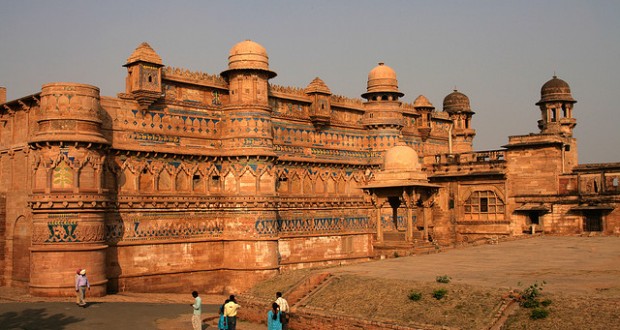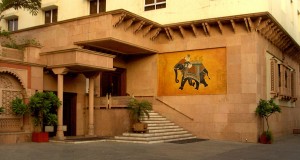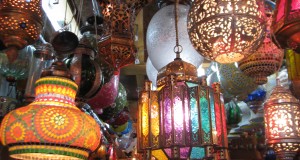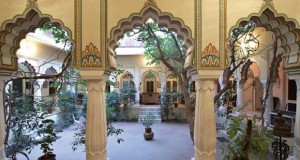Review Overview
3
Summary : The best place to start a tour of Gwalior is at the fort: its commanding view of the city and environs is the best introduction to the area.
The strategically important fort at Gwalior dominates the city and for centuries ailed one of the major routes between north and south India. Its history goes baLk 2000 years, with rock inscriptions from the 5th century still to be found. the 12th century control of the fort and surrounding area passed through a ssion of Muslim, Tomar Rajput, Afghan, Mughal and finally Maratha rulers. during the 12th century Qutb-ud-din-Aibak was the first Muslim ruler to hold it eventually the Tomars took possession. Perhaps the most famous was Man h who came to power in 1487. It was during this period that many of the great battlements and interior palaces were built. After a short period of control he Lodhis (Afghans), the first Mughal Emperor Babur took the fort, and gibed it as ‘the pearl among the fortresses of Hind’. During the slow collapse Moughfal emtpihre thee Scindia line of Marathas conquered the area in 1754. At es during the Maratha wars the British took control of the fort. They held it 30 years after capturing the Rani of Jhansi within its walls in 1858, thus aging to a close the Indian Mutiny.
Once one of the largest and richest of the Indian Princely States, Gwalior is the in tcowitny of a rich agricultural region with an expanding industrial base. The new , Lashkar, is south of the fort; the very smart railway station, to the south-east.
ARRIVAL/DEPARTURE
Air Gwalior is not connected by air to Agra but has daily flights (IC433/434) linking it ith Delhi (Rs738), Bhopal (Rs773), Indore (Rs1083).
Rail Gwalior is on the main line between Delhi and most of the important centres in entral and south India. The Sliatabdi Express leaves New Delhi at 7.15 am and Agra Cantonment Station at 8.15 am reaching Gwalior at 9.30 am, and the Tnj Express leaves Delhi at 7 am and Agra at 10 am arriving at 11.50 am. The return journeys to Agra and New Delhi leave at 7 pm and 5pm, respectively. Tariffs, p.109.
Road There are regular buses from the ISBT in Delhi (Rs150), Idgah bus-station in Agra, and services to and from Jhansi and Bhopal.
What To See
The best place to start a tour of Gwalior is at the fort: its commanding view of the city and environs is the best introduction to the area. Pick up a locally produced guide; the fort is immense and a map will prove valuable. (The old city lies to the north and north-east.) There are two ways of entering the fort: by car, the road skirts the fort and passes the 21 Jain sculptures carved out of the rock between the 8th and 15th centuries. These were mutilated by the first Mughal armies on Babur’s orders. Partial restoration in recent years has replaced the statues’ faces but not their private parts. The road then enters the fort through the Urwahi Gate. On foot, the easiest entrance is via the Alamgir Gate. Taxis and auto-rickshaws can drop you at the top so you can walk down. There is no refreshment stall within the fort so it is advisable to carry a water-bottle–essential in summer.
The fort walls and the buildings within were constructed by different general tions of rulers. The Suraj Kund, inside the outer walls, is an ancient tank at the site of the original pond where Suraj Pal was supposedly cured of leprosy by Saint Gwalipa in AD 8. The Teli-ka Mandir, dedicated to Vishnu and built by the Pratiharas (8th-11th centuries) is one of the oldest buildings in the fort. Intricate stone carvings decorate the doorway. Two 11th-century temples known as the Sas-Bahu ka Mandir, are also dedicated to Vishnu. Their open design contras with the Teli ka Mandir. The 16th-century Gujri Mahal Palace near the Hindola Gate now houses a small Archaeological Museum (open 10 am-5 pm, close Mondays). One of the finest buildings in the fort is the four-storey Man Mandir Palace built in the late 15th century by Raja Man Singh. A blue and patterned tile decoration dominates one side of the fort’s exterior wall. Other buildings interest within the fort are the interconnected Vikramaditya and Karan Palace Some of the buildings complex are only open at certain times of the day and it worth checking before starting the climb.
In the town is a huge 19th-century palace. The enormous Jai Vilas Palac includes what are supposedly a pair of the world’s heaviest chandeliers in the Darbar Hall, and a crystal staircase. The dining table is fitted with an electri train made of silver with which the Maharajah delivered cigars, port, brandy ands other items in crystal wagons to favoured guests. Thirty-five rooms have now been converted to a museum filled with the family’s memorabilia—open 10.3 am-5 pm, closed Monday.
There are two notable tombs in the old town. The early Mughal tomb off Muhammed Ghaus is built as a hexagonal tower with a dome, once covered in blu tiles. The tomb of Tansen nearby commemorates the great musician who played Ft Akbar’s court. Both are located in wasteland about 15 minutes’ walk from the north eastern gate of the fort. The Royal Chhatris or cenotaphs, are near Jayaji Chow) market.
RECREATION Son et Lumiere at the Man Singh Palace in the fort plays every night. There is both Hindi and English language version, and the timings vary so check locally for derails.
SHOPPING Fine saris of a mixed cotton and silk weave from Chanderi, 239 km (148 miles) sou of Gwalior, are available from Kothari and Son, Sarfa Bazaar (tel 23333).
WHERE TO STAY The most expensive hotel in Gwalior is the bland Welcomgroup Usha Kiran Palace next to the Jai Vilas Palace, (tel 23453). Originally the Maharajah’s guest-house, the hotel has an attractive garden and location with all major facilities. Rates Rs1200 upwards. The MP Tourism Hotel Tansen has both air-conditioned and non air-conditioned rooms; centrally located at 6A Gandhi Road (tel 21568) the room rates range from Rs200-Rs650. Other hotels in Gwalior include the Hotel Gwalior Regency on the Bus-stand Road (tel 29516) with air-conditioned rooms ranging from Rs400-650; the Metro Hotel in Ganesh Bazaar (tel 25530) is much simpler and cheaper (Rs200 for an air-conditioned room.)
EATING OUT The Kwality Restaurant in Motilal Nehru Marg and Wengier’s Restaurant rn,e both ine the Laashkar arrea of town (Rs75). The Tansen Hotel and Usha Kiran Palace ice both have restaurants open to non-residents (Rs80 and Rs1200 respectively.
GENERAL INFORMATION Madhya Pradesh Tourism have an information office at the Tansen Hotel (tel 21568). s are available for local excursions and trips to Orchha, Jhansi and Shivpuri- MP Tourism at Hotel Tansen and from S.S. Travels at the Usha Kiran Palace (tel 26636).





